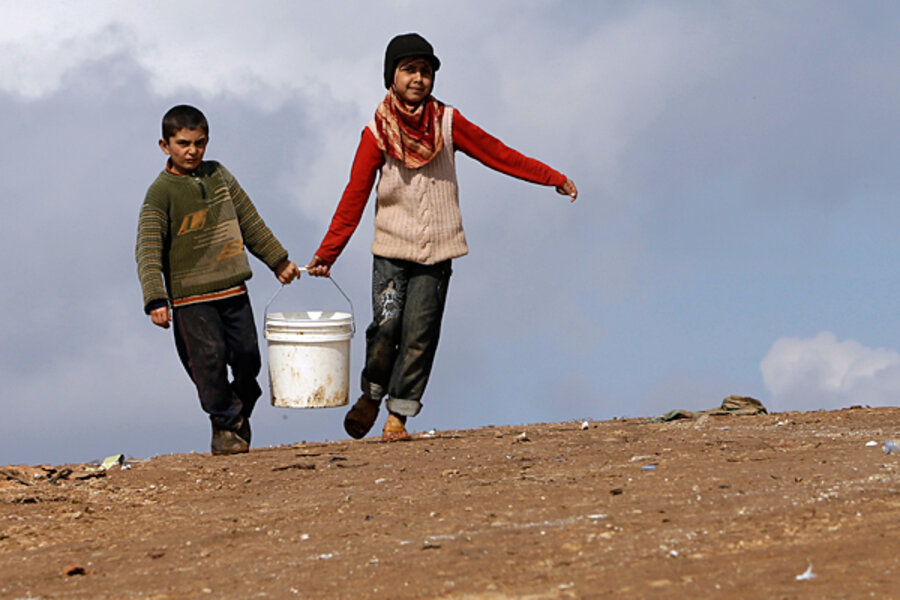Syrians are receiving US aid - they just don't know it
Loading...
| Reyhanli, Turkey
At his tiny hospital in Turkey just a stone’s throw from the Syrian border, Qussay Said Essa says he’s all but given up on American assistance. Though he knows the US has pledged money both inside and outside of Syria, he says he doesn’t know of anyone who has seen American aid.
“What they’ve given is not enough,” says Dr. Essa, a general surgeon at a hospital run by Orient Humanitarian Relief in Reyhanli. “They’ve given what? $350 million over two years? [The actual American pledge is $385 million.] That’s nothing when you compare it to the size of the tragedy and the destruction.”
Just keeping his tiny clinic afloat in Reyhanli costs $200,000 per month and a sister clinic just across the border with better surgical facilities costs another $600,000 per month. Orient Humanitarian Relief, which Essa says receives funding from wealthy Syrian expatriates, is one of many hundreds of small charitable organizations helping those affected by the Syrian crisis that are in dire need of economic support.
Despite US efforts to increase humanitarian assistance to Syria, intended recipients say the American presence remains virtually invisible. Part of the perceived deficit of support comes from the US policy of not branding or labeling aid parcels to identify them as coming from the US. Many in the aid community say that this has resulted in Syrians feeling abandoned by the US.
In a region where perceptions often matter more than reality, the US has failed to convince many Syrians that it is doing good.
“There’s a sense inside Syria that the US has been stringing the Syrian opposition along,” says Christy Delafield, program director for the Syrian Expatriates Organization. “Syrian-Americans have been begging the US to brand aid.… The US is doing some great things and the Syrian people aren't seeing it. When they get aid, they credit the Gulf countries, Turkey, or the Europeans, who do brand."
Early this year, President Barack Obama upped the US aid commitment to Syria from $210 million to $365 million. The money has been focused on providing food and healthcare, with more than half of the funds intended for those still inside Syria.
The US announced today that it will give nonlethal aid directly to the rebels that will include medical supplies and food. The US will also provide $60 million for opposition councils working to provide government services in rebel-controlled areas. This is on top of $50 million that the US has already provided for these groups. Yet the US has intentionally made no effort to communicate to its recipients where the majority of this assistance comes from. Policy makers are concerned that if aid parcels are stamped with American flags or other symbols tying it back to the US, it could endanger the beneficiary or those delivering it inside Syria if they encounter a group hostile to the US.
“We are not putting flags on the aid so that it’s perhaps not as visible as it is in other situations. Our priority is to ensure that it reaches people and that it doesn’t create additional insecurity,” said Nancy Lindborg, USAID’s assistant administrator for democracy, conflict, and humanitarian assistance in recent remarks to the press.
Among those aware of US spending, many allege that a large portion of the money goes to the Syrian government or those inside government controlled areas – areas less likely to be affected by shortages of food and medical supplies than opposition-controlled areas.
American officials remain insistent that no aid goes directly through the Syrian government, but concede that some may reach those sympathetic to the government when aid is disturbed through groups such as the Red Crescent, whose regional employees may still sympathize with the regime. Other projects benefit large swaths of people that include government supporters, as was the case with funding that provided chlorine for municipal water treatment facilities to produce clean water for 10 million people.
“Much of the aid that’s going in is benefiting a broad array of folks throughout Syria,” said Ms. Lindborg.
For the majority of Syrians, the widely held perception remains that what little US assistance has come their way, much of it has gone to the Assad regime, negating any good done by aid to the opposition that could serve to improve the US image among Syrians.
“I know the US has given money but I’m sure this money has gone to the Red Crescent and this organization has helped the regime so what is the benefit of this assistance?” asks Yasir Alsyed, who manages the Recovery House, which helps wounded Syrians in Reyhanli. “The US has not supplied any help to the medical or humanitarian sector,” he adds, stating something that is incorrect.
Meanwhile, the scope of the financial commitment to Syria remains disproportionate to the level of need, which Lindborg and other US officials have admitted. Compared to other foreign aid campaigns, the US effort in Syria remains relatively low. During the 2012 fiscal year, the US pledged $2.3 billion to Afghanistan. Even in countries less central to US interests, American spending still exceeds its investment in Syria. During the previous fiscal year the US planned $676 million for aid spending in Jordan and $383 million in Columbia.
As the Syrian conflict approaches its two-year anniversary, the optimism that permeated the early days is gone and the assumption that it is only a matter of time before Assad steps down has faded away amid statements and other indicators that he will not willingly leave power and his troops remain well-armed and capable. Now many Syrians are hunkering down for a prolonged conflict in which they’re not expecting outside help.
“All these are blow after blow. Syrians really thought the West would come to their aid,” says Mouaz Moustafa, political director of the Syrian Emergency Task Force.







